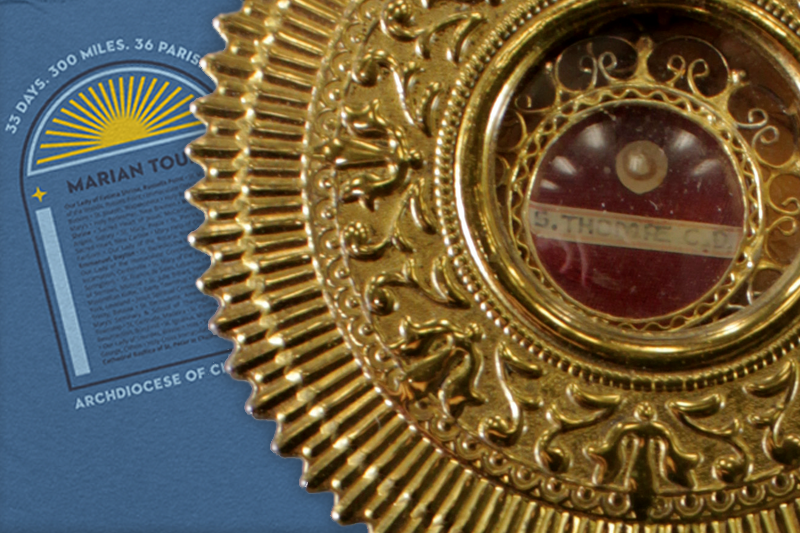Blogs

Pilgrimage: Medieval and Modern
By Kayla Harris
In the Spring of 2021, the Archdiocese of Cincinnati celebrated its bicentennial with a 33-day Marian procession to every deanery in the archdiocese. Beginning on May 16, the pilgrims carried a statue of Our Lady of Fatima over 300 miles, ending their journey June 19 at the Cathedral Basilica of St. Peter in Chains in Cincinnati.
Pilgrimages have been — and still very much are — an important manifestation of devotion for many religions including Christianity, Judaism, and Islam.
Pilgrimage in Christianity
In Christianity, a pilgrimage is often a physical journey to shrines and holy sites of significance in the life of Jesus Christ or other saints. One of the most popular pilgrimage paths is the Camino de Santiago, or the Way of St. James, a 500-mile network of paths in Europe leading to the cathedral of Santiago de Compostela in Spain. One of the best-known Christian pilgrimage routes, the tradition dates to at least the 10th century, when the relics of the apostle St. James were rediscovered in Compostela.
Relics can be the physical remains of a saint or the clothing or objects that belonged to them. They are a reminder that saints were real human beings, and many believe that traveling to view and venerate relics is one way to become closer to God and to receive their intercession. This is one reason for the popularity of pilgrimages to shrines that house saintly relics.
Types of Travel
Definitions differ about what distinguishes a pilgrimage from typical tourism travel. During a visit to the cathedral of Santiago de Compostela in 2010, Pope Benedict XVI issued an address. He stated, “To go on pilgrimage is not simply to visit a place to admire its treasures of nature, art or history. To go on pilgrimage really means to step out of ourselves in order to encounter God where he has revealed himself, where his grace has shone with particular splendor and produced rich fruits of conversion and holiness among those who believe.”
Usually pilgrimages involve physical travel, sometimes on foot, as was the case for the Archdiocese of Cincinnati’s bicentennial pilgrimage. The Basilica of the National Shrine of the Immaculate Conception in Washington, D.C., is designated as a pilgrimage church by the U.S. Conference of Catholic Bishops and welcomes thousands of pilgrims annually from various dioceses and ethnic communities. The Rev. Monsignor Vito A. Buonanno, director of pilgrimages at the National Shrine, has expressed the importance of physical travel, stating, “Sometimes the physicality of the pilgrimage is what is so powerful: Pilgrims are here with other people who share their faith and are journeying for the same reason — and that gives them a bond, a unity and the courage to persevere.”
Shrines, Pilgrims Adjust to Pandemic Restrictions
Even with the conveniences of modern transportation, however, physical travel to shrines is not always possible. Some shrine guidebooks are written specifically for “armchair pilgrims,” or those who use the written word to be spiritually transported to a location that can bring them closer to God. During the coronavirus pandemic, imposed limits on crowd sizes and restrictions on travel have prompted shrines to be creative in engaging pilgrims. This sparked innovation and expanded access to the ritual of pilgrimage.
On July 16, the anniversary of the final apparition of the Blessed Virgin Mary to St. Bernadette Soubirous, the Shrine of Our Lady of Lourdes organized the first worldwide virtual pilgrimage. Re-creating some of the hallmark components of a physical visit to the shrine — such as the recitation of the rosary in several languages, a blessing of the sick, and a torchlight procession — visitors from around the world were able to share the journey in virtual community with others.
Exhibit showcases pilgrimage mementos
Pilgrimage artifacts in the Marian Library and the U.S. Catholic Special Collection are currently on display in the exhibit Journeys of Faith: Shrines, Souvenirs, and Catholic Tourism. For more information visit go.udayton.edu/journeysoffaith
— Kayla Harris is an associate professor and a librarian/archivist in the Marian Library.
